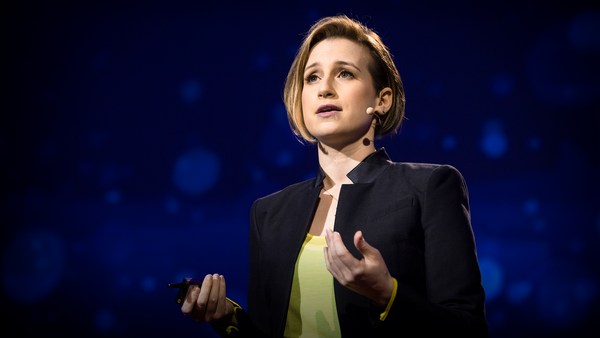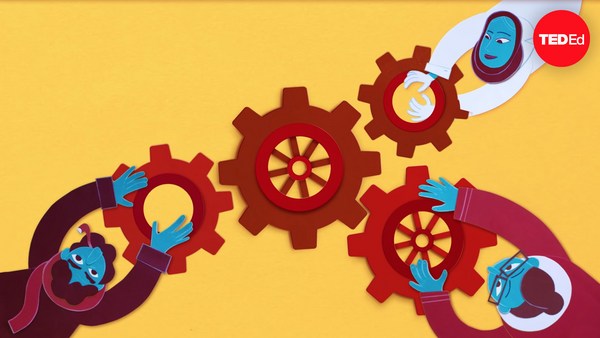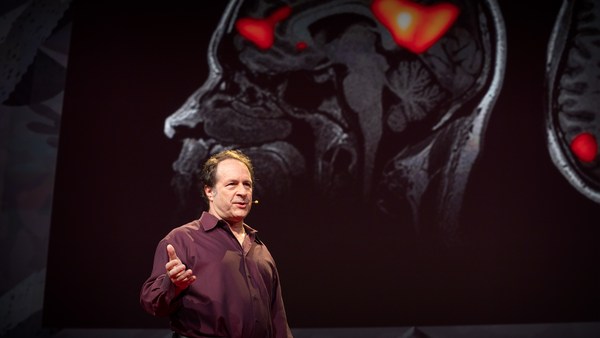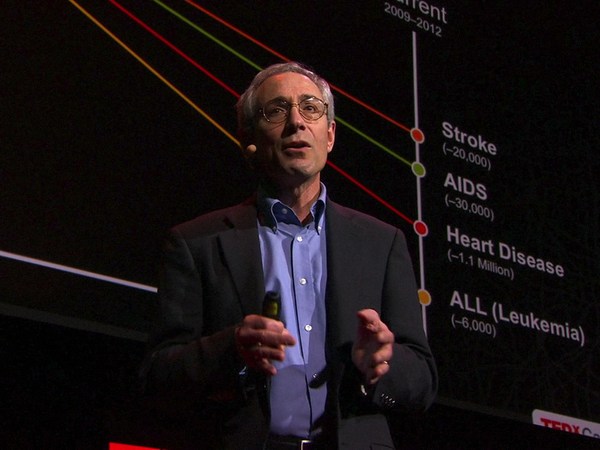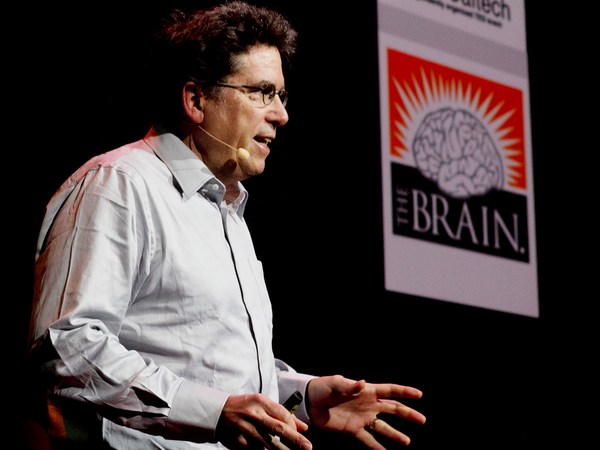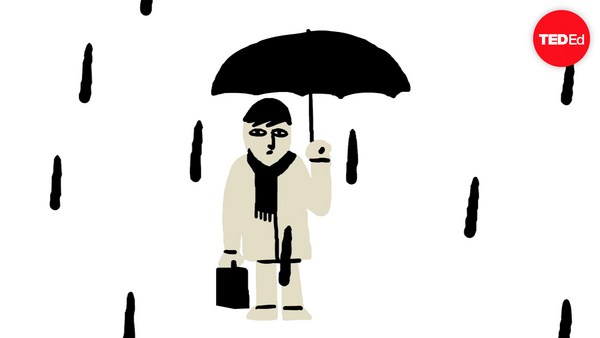I'm going to start by saying something you think you know to be true. Your brain creates all facets of your mind. So then why do we treat mental and physical illnesses so differently, if we think we know that the mind comes from the brain? As a neuroscientist, I'm often told that I'm not allowed to study how internal states like anxiety or craving or loneliness are represented by the brain, and so I decided to set out and do exactly that.
My research program is designed to understand the mind by investigating brain circuits. Specifically, how does our brain give rise to emotion. It's really hard to study feelings and emotions, because you can't measure them. Behavior is still the best and only window into the emotional experience of another. For both animals and people, yes, self-report is a behavioral output.
Motivated behaviors fall into two general classes: seeking pleasure and avoiding pain. The ability to approach things that are good for you and avoid things that are bad for you is fundamental to survival. And in our modern-day society, trouble telling the difference can be labeled as a mental illness.
If I was having car trouble, and I took my car to the mechanic, the first thing they do is look under the hood. But with mental health research, you can't just pop open the hood with the press of a button. So this is why we do experiments on animals. Specifically, in my lab, mice. To understand the brain, well, we need to study brains. And for the first time, we actually can. We can pop open the hood. We can look inside and do an experiment and see what comes out.
Technology has opened new windows into the black box that is our minds. The development of optogenetic tools has allowed us unprecedented control over specific neurons in the brain and how they talk to each other by firing electrical signals. We can genetically engineer neurons to be light sensitive and then use light to control how neurons fire. This can change an animal's behavior, giving us insight into what that neural circuit can do. Want to know how scientists figure this out?
Scientists developed optogenetic tools by borrowing knowledge from other basic science fields. Algae are single-celled organisms that have evolved to swim towards light. And when blue light shines onto the eyespot of an algae cell, a channel opens, sending an electrical signal that makes little flagella flap and propels the algae towards sunlight. If we clone this light-sensitive part of the algae and then add it to neurons through genetic modification, we can make neurons light-sensitive, too. Except, with neurons, when we shine light down an optical fiber deep into the brain, we change how they send electrical signals to other neurons in the brain and thus change the animal's behavior.
With the help of my colleagues, I pioneered the use of optogenetic tools to selectively target neurons that are living in point A, sending messages down wires aimed at point B, leaving neighboring neurons going other places unaffected. This approach allowed us to test the function of each wire within the tangled mess that is our brain.
A brain region called the amygdala has long been thought to be important for emotion, and my laboratory discovered that the amygdala resembles a fork in the road where activating one path can drive positive emotion and approach, and activating another path can drive negative emotion and avoidance.
I'm going to show you a couple of examples -- a taste of raw data -- of how we can use optogenetics to target specific neurons in the brain and get very specific changes in behavior. Anxiety patients have abnormal communication between two parts of the amygdala, but in people, it's hard to know if this abnormality is cause or effect of the disease. We can use optogenetics to target the same pathway in a mouse, and see what happens.
So this is the elevated plus maze. It's a widely used anxiety test that measures the amount of time that the mouse spends in the safety of the closed arms relative to exploring the open arms. Mice have evolved to prefer enclosed spaces, like the safety of their burrows, but to find food, water, mates, they need to go out into the open where they're more vulnerable to predatory threats. So I'm sitting in the background here, and I'm about to flip the switch. And now, when I flip the switch and turn the light on, you can see the mouse begins to explore the open arms of the maze more. And in contrast to drug treatments for anxiety, there's no sedation, no locomotor impairment, just coordinated, natural-looking exploration. So not only is the effect almost immediate, but there are no detectable side effects.
Now, when I flip the switch off, you can see that the mouse goes back to its normal brain function and back to its corner. When I was in the lab and I was taking these data, I was all by myself, and I was so excited. I was so excited, I did one of these quiet screams.
(Silently) Aah!
(Laughter)
Why was I so excited? I mean, yeah, theoretically, I knew that the brain controlled the mind, but to flip the switch with my hand and see the mouse change its behavioral state so rapidly and so reversibly, it was really the first time that I truly believed it.
Since that first breakthrough, there have been a number of other discoveries. Finding specific neural circuits that can elicit dramatic changes in animal behavior.
Here's another example: compulsive overeating. We can eat for two reasons. Seeking pleasure, like tasty food, or avoiding pain, like being hungry. How can we find a treatment for compulsive overeating without messing up the hunger-driven feeding that we need to survive? The first step is to understand how the brain gives rise to feeding behavior. This fully-fed mouse is just exploring a space completely devoid of any food. Here we're using optogenetics to target neurons living in the hypothalamus, sending messages down wires aimed at the midbrain. When I turn the light on, right here, you can see that the mouse immediately begins licking the floor.
(Laughter)
This seemingly frenzied behavior is about to escalate into something I find really incredible. It's kind of trippy, actually. Ready? It's right here. See, he picks up his hands as if he is eating a piece of food, but there's nothing there, he's not holding anything. So this circuit is sufficient to drive feeding behavior in the absence of hunger, even in the absence of food. I can't know for sure how this mouse is feeling, but I speculate these neurons drive craving based on the behaviors we elicit when we target this pathway. Turn the light back off -- animal's back to normal. When we silence this pathway, we can suppress and reduce compulsive overeating without altering hunger-driven feeding.
What did you take away from these two videos that I just showed you? That making a very specific change to neural circuits in the brain can have specific changes to behavior. That every conscious experience that we have is governed by cells in our brain.
I am the daughter of a physicist and a biologist, who literally met on the boat coming to America in pursuit of an education. So naturally, since there was "no pressure" to be a scientist ...
(Laughter)
as a college student, I had to decide whether I wanted to focus on psychology, the study of the mind, or neuroscience, the study of the brain. And I chose neuroscience, because I wanted to understand how the mind is born out of biological tissue. But really, I've come full circle to do both. And now my research program bridges the gap between the mind and the brain.
Research from my laboratory suggests that we can begin to tie specific neural circuits to emotional states. And we have found a number of circuits that control anxiety-related behavior, compulsive overeating, social interaction, avoidance and many other types of motivated behaviors that may reflect internal emotional states.
We used to think of functions of the mind as being defined by brain regions. But my work shows that within a given brain region, there are many different neurons doing different things. And these functions are partly defined by the paths they take.
Here's a metaphor to help illustrate how these discoveries change the way that we think about the brain. Let's say that the brain is analogous to the world and that neurons are analogous to people. And we want to understand how information is transmitted across the planet. Sure, it's useful to know where a given person is located when recording what they're saying. But I would argue that it's equally important to know who this person is talking to, who is listening and how the people listening respond to the information that they receive.
The current state of mental health treatment is essentially a strategy of trial and error. And it is not working. The development of new drug therapies for mental health disorders has hit a brick wall, with scarcely any real progress since the 1950s. So what does the future hold?
In the near future, I expect to see a mental health treatment revolution, where we focus on specific neural circuits in the brain. Diagnoses will be made based on both behavioral symptoms and measurable brain activity. Further in the future, by combining our ability to make acute changes to the brain and get acute changes to behavior with our knowledge of synaptic plasticity to make more permanent changes, we could push the brain into a state of fixing itself by reprogramming neural circuits. Exposure therapy at the circuit level.
Once we switch the brain into a state of self-healing, this could potentially have long-lasting effects with no side effects. I can envision a future where neural circuit reprogramming represents a potential cure, not just a treatment.
OK, but what about right now? If from this very moment forward, each and every one of you left this talk and truly believed that the mind comes entirely from cells in your brain, then we could immediately get rid of negative perceptions and stigmas that prevent so many people from getting the mental health support that they need.
Mental health professionals, we're always thinking about what's the next new treatment. But before we can apply new treatments, we need people to feel comfortable seeking them. Imagine how dramatically we could reduce the rates of suicides and school shootings if everyone who needed mental health support actually got it. When we truly understand exactly how the mind comes from the brain, we will improve the lives of everyone who will have a mental illness in their lifetime -- half the population -- as well as everyone else with whom they share the world.
Thank you.
(Applause)
